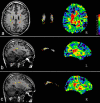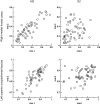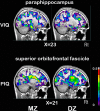Genetic contributions to human brain morphology and intelligence
- PMID: 17021179
- PMCID: PMC6674628
- DOI: 10.1523/JNEUROSCI.1312-06.2006
Genetic contributions to human brain morphology and intelligence
Abstract
Variation in gray matter (GM) and white matter (WM) volume of the adult human brain is primarily genetically determined. Moreover, total brain volume is positively correlated with general intelligence, and both share a common genetic origin. However, although genetic effects on morphology of specific GM areas in the brain have been studied, the heritability of focal WM is unknown. Similarly, it is unresolved whether there is a common genetic origin of focal GM and WM structures with intelligence. We explored the genetic influence on focal GM and WM densities in magnetic resonance brain images of 54 monozygotic and 58 dizygotic twin pairs and 34 of their siblings. For genetic analyses, we used structural equation modeling and voxel-based morphometry. To explore the common genetic origin of focal GM and WM areas with intelligence, we obtained cross-trait/cross-twin correlations in which the focal GM and WM densities of each twin are correlated with the psychometric intelligence quotient of his/her cotwin. Genes influenced individual differences in left and right superior occipitofrontal fascicle (heritability up to 0.79 and 0.77), corpus callosum (0.82, 0.80), optic radiation (0.69, 0.79), corticospinal tract (0.78, 0.79), medial frontal cortex (0.78, 0.83), superior frontal cortex (0.76, 0.80), superior temporal cortex (0.80, 0.77), left occipital cortex (0.85), left postcentral cortex (0.83), left posterior cingulate cortex (0.83), right parahippocampal cortex (0.69), and amygdala (0.80, 0.55). Intelligence shared a common genetic origin with superior occipitofrontal, callosal, and left optical radiation WM and frontal, occipital, and parahippocampal GM (phenotypic correlations up to 0.35). These findings point to a neural network that shares a common genetic origin with human intelligence.
Figures





References
-
- Amunts K, Jancke L, Mohlberg H, Steinmetz H, Zilles K. Interhemispheric asymmetry of the human motor cortex related to handedness and gender. Neuropsychologia. 2000;38:304–312. - PubMed
-
- Amunts K, Weiss PH, Mohlberg H, Pierperhoff P, Eickhoff S, Gurd JM, Marshall JC, Shah NJ, Fink GR, Zilles K. Analysis of the neural mechanisms underlying verbal fluency in cytoarchitectonically defined stereotactic space: the role of Brodmann's areas 44 and 45. NeuroImage. 2004;22:42–56. - PubMed
-
- Andreasen NC, Flaum M, Arndt S. The comprehensive assessment of symptoms and history (CASH). An instrument for assessing diagnosis and psychopathology. Arch Gen Psychiatry. 1992;49:615–623. - PubMed
-
- Ashburner J, Friston KJ. Voxel-based morphometry: the methods. NeuroImage. 2000;11:805–821. - PubMed
-
- Baaré WFC, Hulshoff Pol HE, Boomsma DI, Posthuma D, de Geus EJC, Schnack HG, van Haren NEM, van Oel CJ, Kahn RS. Quantitative genetic modeling of variation in human brain morphology. Cereb Cortex. 2001;11:816–824. - PubMed
Publication types
MeSH terms
LinkOut - more resources
Full Text Sources
